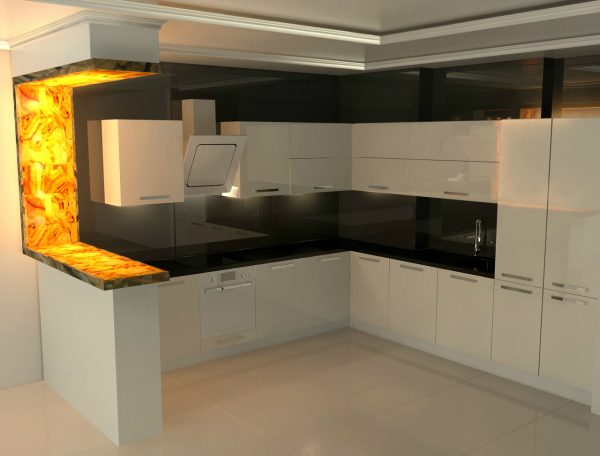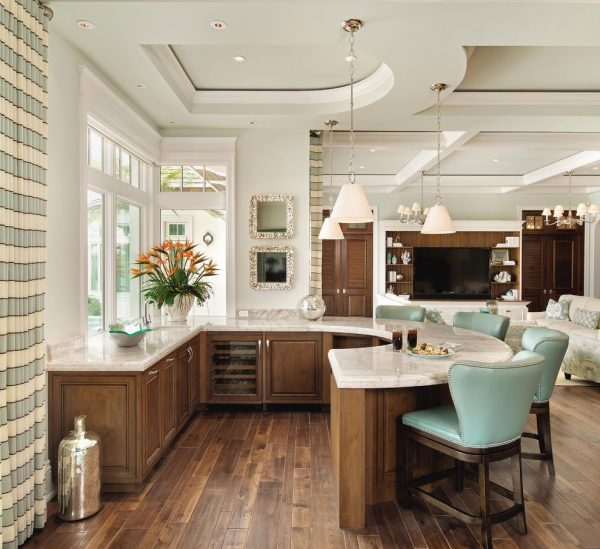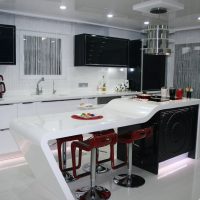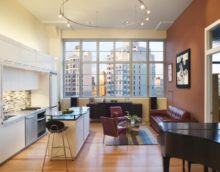Bar counter for the kitchen: basic views, photo designs
Previously, bar counters were used only in bars where you could relax, relax and have a drink. Today they moved to the kitchens at home, took root and became the hallmark of modern interiors. The bar counter for the kitchen can have different shapes and styles. Functionality may also vary.

The bar counter is an excellent attribute of a modern interior.
Content
What is a bar counter?
This is a counter for the sale, bottling and drinking of alcohol. In drinking establishments, she divides the room into two functional zones: a zone for the bartender and for guests. It also protects fragile dishes from breaking, and creates a convenient functional space for the seller. In a modern kitchen, it performs a similar function: it separates the work area from visitors.

In a modern kitchen, a breakfast bar separates the work area from visitors.
Why do we need a bar counter?
As a rule, it is put for its intended purpose: to sit down and drink a cup of coffee, tea or a stronger drink. You can have a quick bite. In exceptional cases, it can be used as an additional working area for cooking.

Bar counter is a great place to have a cup of coffee
It is equally appropriate in large areas, and in small kitchens. The room takes on a complete look, and the space becomes more comfortable.

The bar counter can be installed in any size kitchen
In small spaces, you can use the corner or folding option. A folding bar counter supports all the functionality of a full-fledged model and, if necessary, will be assembled and provide additional space.

Foldable bar counter saves space in the kitchen
Varieties of bar counters
Today the market offers a huge selection of different options for bar counters and surfaces. It can be built into any element of the kitchen, or be a separate element. The design of such a room is always stylish and extraordinary. There are 5 main types of racks:
- classical;
- wall;
- combined;
- island stand;
- two-level.

Stylish bar counter will decorate any kitchen
Wall-mounted rack
One side is attached to the wall. Any side can be adjacent to the wall: short or long. Sometimes it is placed along the window. Perfect for small kitchens, because it can serve as a dining table. Usually there are no cabinets and shelves for storing dishes under it.

Wall bar - a great solution for a small kitchen
Combined rack
In a combined version is a continuation of the kitchen. It can extend the working area, or be perpendicular to the main kitchen elements. In small rooms use the L-shaped option. The height of the countertop is usually equal to the height of the element that it continues. It is convenient when used as an extension of the work surface.
The bar can be positioned higher when the countertops must perform different functions. Such racks are called two-level.

The combined bar counter looks stylish and unusual
Two-tier rack
It is used when it is necessary to separate the execution of different functions, and the space does not allow to place functional elements separately from each other. Typically, the lower level is used as a work area or dining table, and the upper level, for its intended purpose. Ideal for saving space.

Two-level bar counter - ideal for saving space
Island Rack
The most common bar counter. Moreover, it can be combined with an island that performs other functions or perform the function of its direct purpose. The type of adjacency depends only on the design decision and the size of the room.
The bar may be an extension of the island, if space permits. However, such options are very rare. Making them functionally comfortable without compromising design is a complex design task.

The island counter will look best in large and medium sized kitchens
Classic bar counters
This model is used as a separate piece of furniture for the kitchen, regardless of the structural and functional elements. The classic interior of the kitchen with the same bar looks beautiful only in spacious rooms. Most often, it occupies the central part of the room and looks very expensive.

Classic bar counter fits perfectly in large kitchens
Countertop Selection
Bar countertops can be made in one or two-level version. Single-level constructions have a simple design and are suitable in small rooms.
Two options for presenting single-level countertops:
- with top visor;
- without top visor.

Bar counter with a single-level countertop without a top visor
Two-level structures consist of two worktops located at different heights. The top is used for its intended purpose, and the bottom can be used as a dining table or work surface.
The countertop can be made of the following materials:
- laminated particleboard;
- MDF;
- tree;
- natural or artificial stone;
- glass;
- stainless steel.

Kitchen counter with two-level countertop
Particleboard is the most common option. In addition to affordable cost, it has a wide range of colors. However, this countertop has the shortest service life among other materials.

kitchen bar with chipboard worktop
MDF - is the next level. MDF boards are coated with plastic or thermal film, which adds resistance to humidity and temperature changes. However, the decorative coating wears out quickly.
Natural wood in any interior has always been a sign of taste and style. The tree is environmentally friendly, pleasant to the touch, durable. Such a countertop requires appropriate care. To increase the service life and maintain the structure of the tree, the tree is coated with a special varnish. A bar made of wood for the kitchen has only one drawback - the high cost.

Two-level bar counter for kitchen with MDF worktop
The stone has always been famous for its attractiveness and durability. For example, marble looks beautiful, but is afraid of food colors, fats, acidic environments. An alternative could be artificial stone countertops. Durability, lower price (relative to natural stone), non-toxic and beautiful.
Glass racks give ease to space, are fireproof and resistant to moisture. However, such countertops are impractical because glass can break. Another disadvantage is the high cost.

Kitchen counter with faux stone worktop
Accommodation options
To make the bar look beautiful and fulfill its function, its placement should be thought out in advance. There are several layout options for a kitchen with a breakfast bar.
A peninsular view of the kitchen is the most common accommodation option.The tabletop is perpendicular to the main headset, clearly dividing the room into two functional zones.

Peninsular view of the kitchen - the most common option for placing a breakfast bar
In large rooms, you can install a large countertop near the window to beautifully beat the unused room. The rack combined with the windowsill will look beautiful.

In large rooms, you can install a large countertop near the window
Linear placement is commonly used in wall construction. The countertop continues the headset. It can be located immediately after the working surface to increase the working area, or as a table for eating.

Linear placement of the bar counter for the kitchen
The island version of the location will look very nice. But, only if the size of the room allows.

Island option for the kitchen bar
Accessories and fittings
Additional accessories, fixtures and fittings make the bar surface more practical. Below are some elements that can complement the bar:
Reiling.
The crossbar attached to the rack. Serves for hanging shelves, hooks and holders. Most often acts as the basis for other accessories.

Bar counter for kitchen with railing
Hooks
They are used for hanging other cutlery and dishes (mugs, knives, ladles, etc.).
Holders. Used for hanging glasses and cups.

Kitchen counter with hooks
Shelves.
Usually used in the center and round shape. Ideal for fruits, wine, pastries and other products.

Bar counter for kitchen with shelves
Backlight
Adds light and style to the interior of any room. It is better to choose an LED. It can be placed around the perimeter, contour or other elements. Which expands the capabilities of the designer. LED backlight lasts longer than conventional lamps.

Illuminated kitchen counter
Kitchen counter design
The bar counter is a great solution to increase practicality. With its help, you can optimize the space and divide it into functional zones. If you approach the choice of such an element responsibly - it will become an indispensable functional interior solution.

The bar counter is a great solution to increase practicality.
Useful tips for choosing a bar
Thinking over the interior of the kitchen, you must immediately determine: what role will be assigned to the bar counter?
- breakfasts and light snacks;
- dinner table;
- working surface;
- zoning element;
- bar.

Kitchen counter with dining table function
The destination depends on the location, appearance, accessories, as well as the materials of the future product.
When the purpose is determined, you can begin to choose the appearance of the rack, as well as options for its location. Here you should take into account the size of the room, its shape and interior. An important factor is the purpose of the room: kitchen, living room, kitchen combined with the living room, or another?

Bar counter for the kitchen combined with the living room
The appearance and material of the bar counter is best chosen as close as possible to the interior of the room. However, it should be noted that the minimum rack width should be 40-50 cm. Narrower options will be inconvenient to use.

The appearance and material of the bar counter is best chosen as close as possible to the interior of the room
Height is best chosen by the height of the element to which it is adjacent. If the stand is island - the optimum height is 85-120 cm.
The length is determined only by the size of the room, and its appearance. Racks can be short from 1.5-2 m. To the length of the wall.
It is better to leave the design and selection of parameters to a professional interior designer, so that the counter fits exactly into the interior of the kitchen. The best option would be to design along with the design of the kitchen.

The design and selection of bar counter parameters is best left to a professional interior designer
Kitchen design with breakfast bar































































